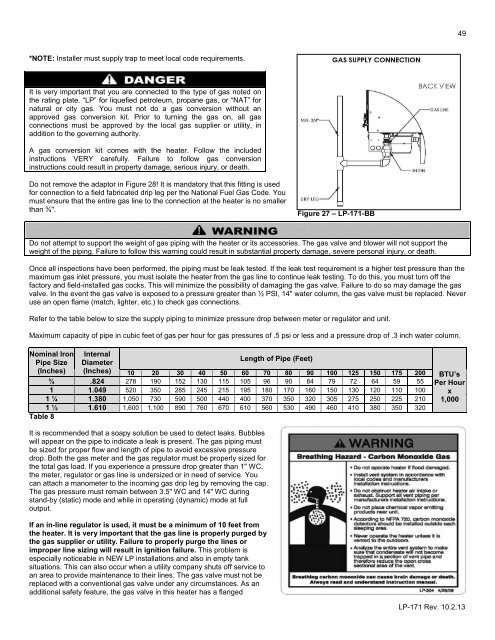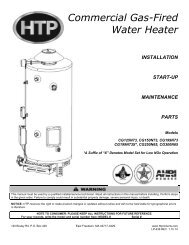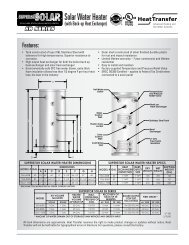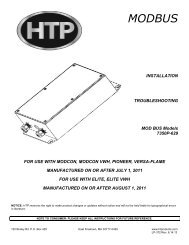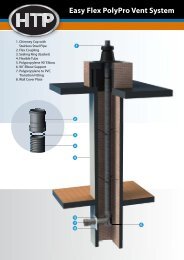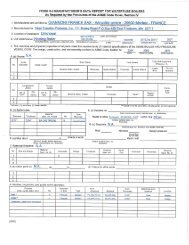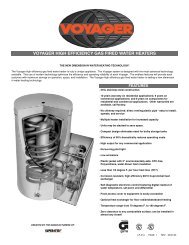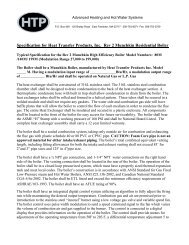MC Series Gas-Fired Circulating Heater - Heat Transfer Products, Inc
MC Series Gas-Fired Circulating Heater - Heat Transfer Products, Inc
MC Series Gas-Fired Circulating Heater - Heat Transfer Products, Inc
Create successful ePaper yourself
Turn your PDF publications into a flip-book with our unique Google optimized e-Paper software.
49<br />
*NOTE: Installer must supply trap to meet local code requirements.<br />
It is very important that you are connected to the type of gas noted on<br />
the rating plate. “LP” for liquefied petroleum, propane gas, or “NAT” for<br />
natural or city gas. You must not do a gas conversion without an<br />
approved gas conversion kit. Prior to turning the gas on, all gas<br />
connections must be approved by the local gas supplier or utility, in<br />
addition to the governing authority.<br />
A gas conversion kit comes with the heater. Follow the included<br />
instructions VERY carefully. Failure to follow gas conversion<br />
instructions could result in property damage, serious injury, or death.<br />
Do not remove the adaptor in Figure 28! It is mandatory that this fitting is used<br />
for connection to a field fabricated drip leg per the National Fuel <strong>Gas</strong> Code. You<br />
must ensure that the entire gas line to the connection at the heater is no smaller<br />
than ¾".<br />
Figure 27 – LP-171-BB<br />
Do not attempt to support the weight of gas piping with the heater or its accessories. The gas valve and blower will not support the<br />
weight of the piping. Failure to follow this warning could result in substantial property damage, severe personal injury, or death.<br />
Once all inspections have been performed, the piping must be leak tested. If the leak test requirement is a higher test pressure than the<br />
maximum gas inlet pressure, you must isolate the heater from the gas line to continue leak testing. To do this, you must turn off the<br />
factory and field-installed gas cocks. This will minimize the possibility of damaging the gas valve. Failure to do so may damage the gas<br />
valve. In the event the gas valve is exposed to a pressure greater than ½ PSI, 14" water column, the gas valve must be replaced. Never<br />
use an open flame (match, lighter, etc.) to check gas connections.<br />
Refer to the table below to size the supply piping to minimize pressure drop between meter or regulator and unit.<br />
Maximum capacity of pipe in cubic feet of gas per hour for gas pressures of .5 psi or less and a pressure drop of .3 inch water column.<br />
Nominal Iron<br />
Pipe Size<br />
(<strong>Inc</strong>hes)<br />
Internal<br />
Diameter<br />
(<strong>Inc</strong>hes)<br />
Length of Pipe (Feet)<br />
10 20 30 40 50 60 70 80 90 100 125 150 175 200<br />
¾ .824 278 190 152 130 115 105 96 90 84 79 72 64 59 55<br />
1 1.049 520 350 285 245 215 195 180 170 160 150 130 120 110 100<br />
1 ¼ 1.380 1,050 730 590 500 440 400 370 350 320 305 275 250 225 210<br />
1 ½ 1.610 1,600 1,100 890 760 670 610 560 530 490 460 410 380 350 320<br />
Table 8<br />
BTU’s<br />
Per Hour<br />
x<br />
1,000<br />
It is recommended that a soapy solution be used to detect leaks. Bubbles<br />
will appear on the pipe to indicate a leak is present. The gas piping must<br />
be sized for proper flow and length of pipe to avoid excessive pressure<br />
drop. Both the gas meter and the gas regulator must be properly sized for<br />
the total gas load. If you experience a pressure drop greater than 1" WC,<br />
the meter, regulator or gas line is undersized or in need of service. You<br />
can attach a manometer to the incoming gas drip leg by removing the cap.<br />
The gas pressure must remain between 3.5" WC and 14" WC during<br />
stand-by (static) mode and while in operating (dynamic) mode at full<br />
output.<br />
If an in-line regulator is used, it must be a minimum of 10 feet from<br />
the heater. It is very important that the gas line is properly purged by<br />
the gas supplier or utility. Failure to properly purge the lines or<br />
improper line sizing will result in ignition failure. This problem is<br />
especially noticeable in NEW LP installations and also in empty tank<br />
situations. This can also occur when a utility company shuts off service to<br />
an area to provide maintenance to their lines. The gas valve must not be<br />
replaced with a conventional gas valve under any circumstances. As an<br />
additional safety feature, the gas valve in this heater has a flanged<br />
LP-171 Rev. 10.2.13


